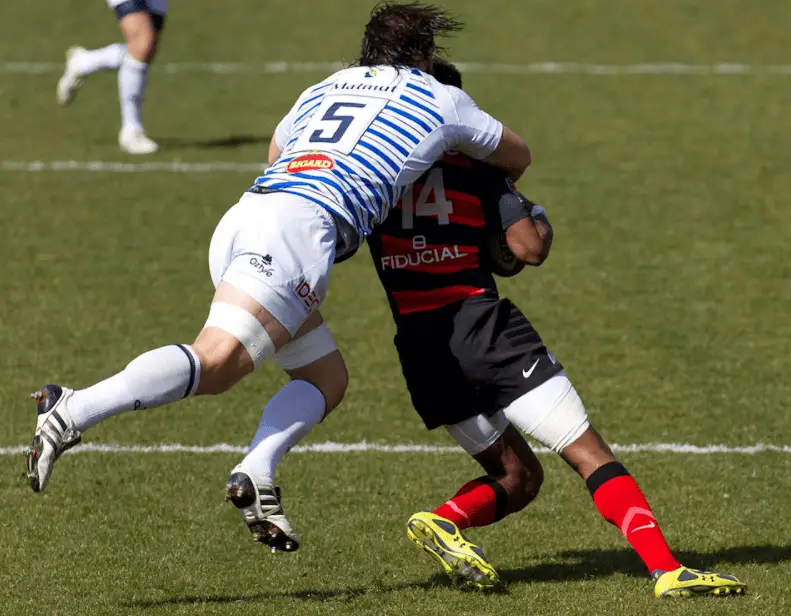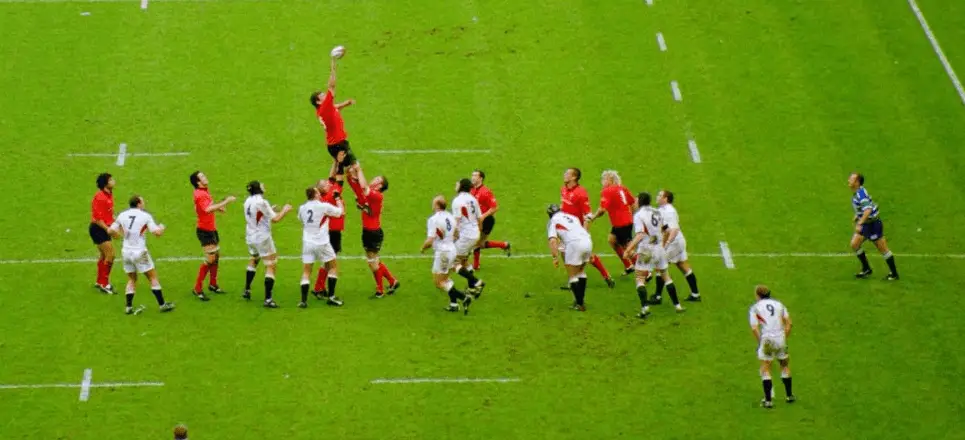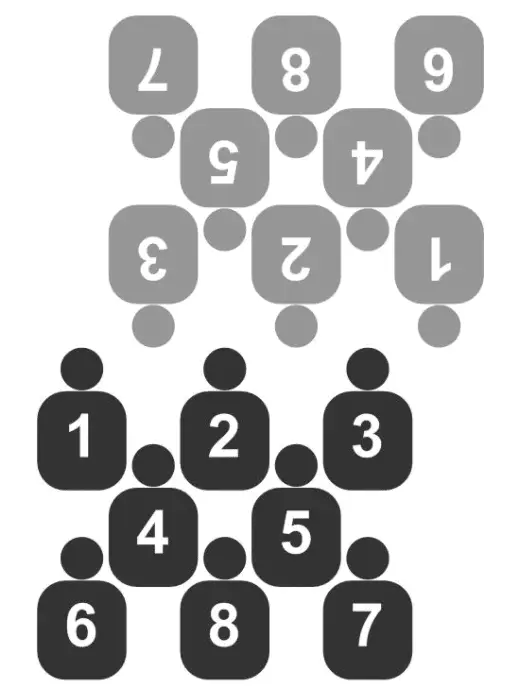Welcome! Although rugby union is simple in many ways the number of rules it has can be off putting. That is why I have put together this guide to the basic rules of rugby to try and increase people’s understanding without having to read the official 150 page rugby rule book. Rugby is a great game and I hope this guide helps you to get involved in it even more!
This guide provides abbreviations and summaries of rules for the vast majority of aspects of play but, first, in case you are brand new to rugby lets cover the basic principles:
As you probably want to focus on different parts of the game you may explore this pages contents using the links below to suit your purpose:
The Basic Rules Of Rugby
- Teams aim to carry the ball over the opponents’ goal line and force it to the ground to score.
- Players may only pass laterally or backwards.
- Players can carry the ball and run with it in any direction.
- Players can kick the ball from hand in any direction at anytime.
- If the ball goes out of play there will be a lineout.
- If the player is dropped or passed forward there will be a scrum.
- If the players are tackled to ground a ruck will form.
- If a player is helped up in the tackle a maul will form.
The Main Objective Of Rugby union
The main objective of rugby union is that you must carry the ball usually forwards, pass the ball backwards, or kick the ball forwards in order to move closer to the opponents line and score a try by touching the ball down over the opponents try line.
If the ball goes out of play there will be a lineout. If the ball is dropped or passed forwards there will be a scrum and when there is a tackle, a ruck or maul will be formed in order to continue play.
Suggested reading: What is Rugby Culture Like?
The Basic Rules of Scoring In Rugby
You can score points in rugby by placing the ball on or over the opponents try line and exerting downward pressure with control to score a try, 5 points. You can also kick a conversion after a try for 2 points, or you can kick a penalty, or drop a goal for 3 points.
| Method of scoring | Number of points |
| Try | 5 |
| Conversion | 2 |
| Penalty try | 3 |
| Penalty goal | 3 |
| Drop goal | 3 |
Try scoring: To score a try you must place the ball on or over the opponents try line and exert downward pressure. Essentially players literally put the ball down over the line, placing it on the floor, or sometimes they fall on a loose ball pushing it downwards.
Conversions: After a try there will be a conversion. The kicker, normally the person who plays fly half but it can be anyone, places the ball on a kicking tee to hold the ball upright and attempts to kick the ball over the crossbar and between the posts.
The kick must be placed in a direct line backwards from the point at which the try was scored. The kicker can choose how far backwards they kick the ball from. A player has one minute to kick the ball.
Penalty try: If one team stops the other from scoring a try by breaking the rules in some way then a penalty try will be awarded and the conversion will be taken from in front of the posts. This usually happens when an opponent slaps down a pass with their hand to stop a player scoring, or when a scrum is going backwards and the defending team pulls the scrum down to stop it moving.
Penalty kicks: If one team breaks the rules then a penalty may be awarded. The attacking team can then choose to tap the ball with their foot and run with it, kick it to touch, or place the ball on the floor and attempt to kick the ball through the posts and over the crossbar in the same manner as a conversion kick.
Drop goals: In open play, any player may drop the kick the ball through the posts and over the cross bar and score three points. Often this is dne from scrums, rucks and mauls inside the opponents 22 metre line and in front of the posts.
Recommended for you: Rugby Ball Size Guide Per Age Group
The Basic Rules For Kickoffs And Restarts

To start the game, there is a drop kick from the centre circle. The ball must go at least 10 metres and players normally kick it as high as possible so that their own players have time to run underneath the ball and compete with the opposition to catch it.
The team who scores a try restarts the game with a drop out at the centre circle. The team receiving the ball can lift players into the air to get an advantage and catch the ball. The players chasing the ball must be behind the kicker/halfway line until they actually kick the ball.
If the ball goes out over the deadbal line/the very last line on the pitch at either end then the game restarts with a drop out on their own 22 by the defending team.
What is a kick off called in rugby?
In rugby union, a ‘kick off’ can simply be called a ‘kick off’, however, technically the initial kick is a drop kick and you will sometimes here the term ‘drop out’ used as the term for a kick off.
Can you score from a kick off in rugby?
You cannot score any points via kicking directly for the posts from a kick off/drop out in rugby, however, you can catch the ball and then score by running and passing with ball in hand directly from the kick off.
Suggested reading: What Are Rugby Union Half Time Rules?
Basic Rules For Players On The Ground

When a player is tackled to the ground they can immediately move their body shape to protect the ball from the opposition and place the ball back towards their supporting teammates, or pass the ball off the floor. The opposition tackler has to immediately release the tackled player and get out of the way.
If the tackler does not immediately move to get out of the way they give away a penalty. If the tackled player continues to move on the floor for too long in order to protect the ball from the opposition, or they hold onto the ball whilst an opponent, who is on their feet, tries to wrestle the ball from them, then they will concede a penalty.
Suggested redaing: Can you play rugby on an artificial pitch?
Can you pass off the ground in rugby?
You can pass off the ground in rugby so long as it is within the first few seconds of the tackled player hitting the ground. You are supposed to pass immediately on hitting the ground although in reality referees usually allow a few seconds to do so.
What happens if the ball touches the ground in rugby?
If a player drops the ball to the ground forwards then an advantage will be played to the opposition team. If there is no advantage then a scrum will ensue. If a player drops the ball to the ground backwards then it is ‘play on’ as no offense has occurred.
If a player kicks the ball in any direction and it hits the ground then it is ‘play on’ also. If a player is tackled to the floor then they must immediately present the ball to their team mates usually by placing the ball on the ground in the direction of their team mates and a ruck will then ensue.
Basic Rules Concerning Knock Ons and Forward Passes
Any time a player drops the ball forward or passes the ball forward (lateral is ok) then a scrum will be awarded to the opposition team.
However, if a player knocks the ball forward when attempting to charge down (block a kick) then it will not be a knock on and play will actually be allowed to continue. It is also not a knock on if a ball goes forward off a players head.
This sometimes happens following a kick charge down or when a player gets in the way of a long fast pass not intended for them.
What is a knock on in rugby?
A ’knock on’ is when a player drops the ball and it goes forwards out of the hand of the player and touches either the ground or an opponent. A scrum will be awarded to the opposition if there is no advantage to the opposition in playing on.
A knock on does not count if it comes off the head of a player, or if the knock on occurs whilst a player is charging down a kick or if the ball comes off any part of the body apart from the hands and/or arms.
Is a deliberate knock on a yellow card?
A deliberate knock on is a yellow card offence and often occurs when a player attempts to intercept a ball with one hand. If the referee deems they have a realistic chance of catching the ball then it may not be given as a deliberate knock on. However, in recent years referees have tended to say that it is a deliberate knock on unless the player going for the ball is going for it with two hands.
A deliberate knock on also often occurs when a player who is about to tackle the ball carrier, who is in the process of passing the ball, throws their arm out to the side in an attempt to wrap their arms around the ball carrier but at the same time knocks the pass forward, often unsighted.
This can often stop a try and it is often difficult for the referee to determine if it is deliberate or not. In recent years though, if a try was likely to be scored the referee will award a penalty try and give a yellow card to the player deliberately knocking the ball on even though this is somewhat open to interpretation.
Does the ball have to hit the ground in order for it to be a knock on?
The ball has to either hit the ground, or another player in order for it to be judged a knock on and it must also have travelled forwards off the hands, or arms of a player.
Recommended for you: Red Cards Explained: Detailed Guide
Basic Rules Of The Tackle
Tacklers must immediately release the tackled player and the ball once they hit the ground as well as move/roll away from the tackled player. They must also allow the tackled player to release or move away from the ball. The tackled player must either release the ball, present it to a teammate, pass it off the floor, move away from the ball or get up.
Tacklers must also return to their feet before they attempt to play the ball again. They must also allow the tackled player to release the ball, move away from the ball, or get up. The tackler must not fall over the top of the ball preventing it from being played by the opposition.
What is an illegal tackle in rugby?
A tackle is illegal in rugby union if any of the following occur:
- the tackler does not attempt to wrap their arms around the player
- the tackler makes contact above the collarbone line
- the tackler raises the hips of the tackled player above their head (tip tackle)
- the tackler launches themselves along the ground in a very low position and does not use their arms (chop tackle).
- The tackle is late, i.e the tackler could have drawn out of the tackle but instead followed through.

Basic Rules Of The Ruck
A ruck is formed when at least one player from each side comes into contact with an opposition player to compete for the ball which is on the floor with a tackled player. Players entering the ruck to compete must try to stay on their feet, join from the hindmost foot and must not attempt to collapse the ruck by pulling an opponent down.
More players can join the ruck but they must join alongside the last player in the ruck and they must bind onto them simultaneously. Heads and shoulder must never go below the height of a players hips. Players can use their feet to move the ball back on their side.
When a ruck forms it creates an offside line at the back foot of the hindmost player in the ruck. All the players not involved in the ruck must stay on or behind this line or risk giving away a penalty.
What is the difference between a ruck, a maul and a scrum?
A ruck occurs during open play when a player is tackled or falls to the ground, the ensuing competition to drive over the top of the ball by players is known as a ruck. For a maul, however, the tackled player manages to stay on their feet and other players join them to wrestle for the ball, this is known as a maul. A scrum on the other hand is not from open play, it is a set piece, and a way of restarting the game usually following a knock on.
In case you are interested: Rules For Rugby Gloves: Benefits And FAQs
Basic Rules Of The Maul
Mauls allow players to compete for the ball when a tackle occurs and the tackled player remains on their feet. A minimum of three players are involved: the tackler, tackled player and one more player from either side.
The maul must always be moving towards one side or the others goal line. If it remains static for more than 5 seconds then the side who took the ball into the maul hand the ball over to the opposition for a scrum.
For a full guide to rugby mauls go here: Rugby Mauls Explained (FAQs)

Basic Rules Of The Mark
A player can deliberately stop the game and gain a free kick by calling a ‘mark’. This can be done when the ball is kicked into the air and the player catching the ball is inside their own 22 metre area when they catch the ball and they shout ‘mark’.
The reason to do this is so that the game stops and the player can then compose themselves, take their time and put in a good kick down field. Marks cannot be claimed off any restart kicks such as kick offs.
Why is a catch called a mark?
A catch may be called a ‘mark’ because in years gone by in order to claim a mark, the catcher had to stamp the heel of their foot into the ground and literally make a markin the pitch surface. Nowadays, players only have to shout ‘mark’ and players generally also raise an arm immediately after, although this is not actually required in the rules of the game.
Further reading: Can You Tackle From Behind? (3 Tackle Types)
Basic Rules Of Touch
When either the ball, or any part of a player carrying the ball touches the side boundaries of a pitch, known as touch lines then the ball is out of play and a lineout will ensue. This is a means of restarting the game in a competitive manner.
At the point where a player went into touch or where the ball crossed over the touch line a lineout will form.
When can you kick for touch in rugby?
You can kick for touch at any time and from anywhere in rugby. If you are kicking the ball from inside your own 22 metre line, you can kick the ball directly into touch without the ball bouncing. However, from outside your 22 metre line the ball must bounce before going into touch otherwise the lineout will be taken right back from where the kick was taken from.
Remember that on the line is out in rugby union. So, a kick from outside the 22 metre area which lands on the touch line, even if it is only a fraction of the ball, will result in a lineout level with where the ball initially went out.
You can read my guides to the different types of kicking here and and my fascinating explanation as to why there is so much kicking in rugby here.
Basic Rules Of The Lineout And How They Work

At the point where the ball went into touch, each team forms a line of players beginning on the 5 meter line and stretching out to no further than the 15 meter line. The lines stand one meter apart and the ball is thrown down the middle for players to jump or be lifted into the air to compete for.
Quick Throw ins
Rather than setting up a 2-7 man lineout a quick throw in can be taken where a player can throw the ball in from anywhere between where touch was made and their own goal line. The ball must travel 5 meters and it must go laterally or backwards.
For full details on how lineouts work and their rules please go here.
Basic Rules Of The Scrum
A scrum is a way of restarting the game with a contest for the ball usually following: a knock on, a forward pass, a lineout throw that is not straight, when the ball gets stuck in a ruck or maul, or as a choice following a free-kick or penalty amongst other reasons.
Our full guide to the rules of the scrum is here.

Suggested reading: Rugby Shin Guards: Who Wears Them And Why?
Basic Rules Of The ‘Advantage’ Law
If one team makes a mistake such as dropping the ball forward, gets caught offside, or breaks another law of the game, the referee may allow play to continue to see if the opposition can benefit from the mistake that was made, rather than stopping the game unnecessarily.
You might be interested in: Rugby Union: Extra Time, Overtime, and Injury Time Rules Explained (Examples)
Basic Rules Of Foul Play, Penalties And Free Kicks
To restart the game after one team has committed an infringement the referee will award a penalty, or a free kick depending on the severity of the offence.
Penalties are commonly given for: players not releasing the ball on the floor, players not moving away from the tackler on the floor, players collapsing mauls and players being offside, i.e. not staying behind the hindmost foot of a breakdown situation.
Our full guide to penalties, free kicks and foul play is here.
Where To Now?
All of the rues on this page can be explored in more detail in the official guide from World Rugby which is located here. It is not the most riveting read but if you need to know more detail than I have provided then that is the place to go.
At the time of writing World Rugby are trialing different rules i an attempt to speed the game up, including things such as: a captain’s challenge, golden points, goal line drop outs, and the mark rule. You can read more from World Rugby about this here.
You may be aware that the rules of rugby are modified for younger players in order to make the game more accessible and fun for them. To read more about the rules for different age groups please take a look at our Age Grade Rules Guide
You may also be interested in the rules for rugby boots here, or what rugby players wear here.
Photo Credits
Referee checking boots OnTask, CC BY 2.0, via Wikimedia Commons.
Photo 2: England Vs Wales Junior World Cup Final 2013. Fab5669, CC BY-SA 3.0, via Wikimedia Commons.
Photo 3: Saracens ruck 2015 Clément Bucco-Lechat, CC BY-SA 3.0, via Wikimedia Commons.
Photo 4: Gloucester Rugby maul 2014 Clément Bucco-Lechat, CC BY-SA 3.0, via Wikimedia Commons.
Photo 5: England v Wales, Twickenham, 2004 User Gareth Owen on en.wikipedia, CC BY-SA 3.0, via Wikimedia Commons.
Photo 6: License no required: https://commons.wikimedia.org/wiki/File:Image-Rugby_Union_Scrum.jpg

